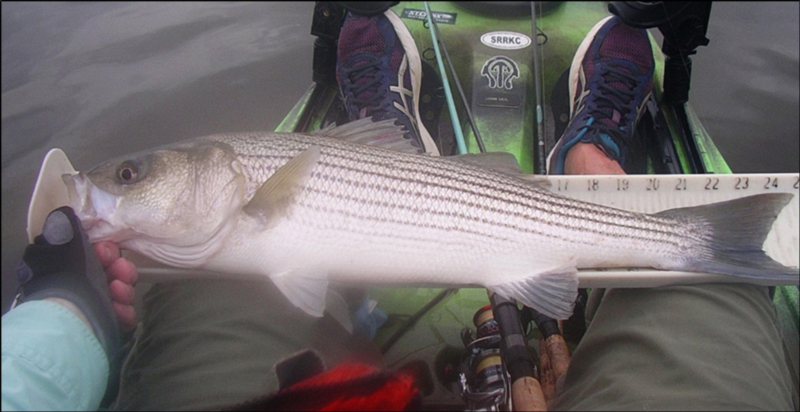It’s quite exciting to be paddling along, kayak fishing with several rods out while you troll, and suddenly have one of those rods begin shaking wildly just a few feet from your face. Grabbing the rod and winding in the fish while trying to keep the kayak under control is challenging — and fun.

When it’s clear that a fish is on the line, stop paddling (or pedaling) and lay the paddle across your lap. Then you can remove the rod from the holder and give a tug to make sure the hook is set. Then begin winding in the fish.
For smaller fish you can wind them straight in, but with larger fish you may need to take your time and follow the fish as it swims around. If necessary, when fighting a large fish I hold onto the rod with one hand and use the paddle in the other hand to make a small adjustment to the kayak’s angle and position. I may pull the rod toward me, then wind in line as I slowly allow the rod to swing back toward the fish. This pumping motion helps to keep pressure on a strong fish. If you do pump the rod in that manner, do your best not to give slack in the line at any point.
In a kayak you’ll lose forward momentum as soon as you stop paddling or pedaling, and the kayak may twist sideways or drift backwards. These movements increase the likelihood of tangling with one of your other trolling lines. When coaching inexperienced kayak trollers, I suggest that they start by trolling just one or two lines to minimize this problem. Once they grow comfortable with the motions, they may add a third rod.
Sometimes I still troll just two lines myself. In 2015 I launched my kayak off the beach at Cape Henlopen State Park and began trolling three rods with large soft plastic lures. Once I found the fish, I realized that having three lines in the water was foolish and put one rod away. Over the next two hours I had bluefish longer than 30-inches on both rods at the same time on a few occasions. My strategy for the double hookups was to fight the first fish until the second rod began shaking, then loosen the drag on the first reel and set the rod in a holder. Then I picked up the second rod and focused on bringing that fish in before returning to finish the first fish. Having a 36-inch bluefish with a mouth full of sharp teeth lying at my feet while fighting another was a bit nerve-wracking, but I still have all my toes and caught eight of those huge fish before all the lures and leaders I had with me were destroyed.
Still, some tangling of lines after hooking a fish is inevitable. Although I dislike having to stop fishing to untangle lines, I also realize that I am out there to catch fish and sometimes catching fish while trolling leads to tangles.
- Excerpted from John Veil’s latest book “The Way I Like to Fish - A Kayak Angler’s Guide to Shallow Water, Light Tackle Fishing,” available at Amazon or by emailing [email protected]